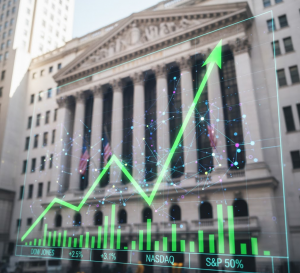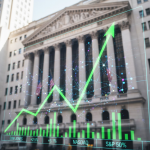Navigating the Summit: An Investor’s Guide to All-Time Highs
It’s one of investing’s great paradoxes: the view is best from the top, but it’s also where the fear of heights kicks in.
Examining the markets, we see this unfolding in real time. Indices like the S&P 500 are charting new territory, pushing past milestones that seemed distant just a year ago. The S&P 500: 6,664.36 reached a new record high as of September 19, 2025. On the surface, it’s a time for celebration. Yet, a palpable anxiety hangs in the air. The question on every investor’s mind is, can this last?
This is a healthy question, but it often leads to an unhealthy conclusion: panic. The market isn’t a monolith; it’s the sum of millions of decisions made in the face of powerful, conflicting global crosscurrents.
Think of the market as a driver cruising at high speed on a sunny day. The engine is running smoothly, and performance is excellent. But now, warning signs are appearing: “Potential Hazards Ahead.” This doesn’t mean we slam on the brakes. It means we take our foot off the accelerator, get both hands on the wheel, and pay close attention to the road.
Those hazards are not phantoms. They are complex geopolitical, regulatory, and economic challenges reshaping the investment landscape.
The Three-Front War: Mapping the Global Risks
For decades, investors treated geopolitics as a secondary concern—a source of temporary, headline-driven volatility. That era is over. Today, the global chessboard is the primary arena where the winners and losers of the next decade are being determined. Three fronts demand attention.
1. The U.S.-China Tech Rivalry: A New Cold War
The most significant force shaping the global economy is the strategic rivalry between Washington and Beijing. For decades, they operated on a symbiotic model: the U.S. designed the blueprints, and China used its unmatched manufacturing scale to build the final products.

That relationship has fractured. The U.S., citing intellectual property theft and unfair state subsidies, has declared its most advanced tools, particularly high-end semiconductors, off-limits to China. Beijing, in turn, is retaliating and aggressively investing to achieve technological self-sufficiency.
This is a fundamental decoupling in the most critical sectors of the 21st-century economy. The battlegrounds include:
- Advanced Semiconductors: U.S. export controls are designed to slow China’s progress in AI and supercomputing. This directly impacts American chip designers like NVIDIA (NVDA) and AMD (AMD), for whom China has been a massive market, and creates uncertainty across the entire global tech supply chain.
- Electric Vehicles (EVs): The recent imposition of steep U.S. tariffs on Chinese EVs and batteries is a preemptive strike to protect nascent Western green industries from a flood of lower-cost competition. The United States has implemented a significant 100% tariff on electric vehicles (EVs) imported from China. This measure, which took effect in late September 2024, is aimed at protecting domestic automakers from what the U.S. government has described as unfair trade practices and state-sponsored subsidies within the Chinese EV industry.
- The “China +1” Strategy: In response, companies like Apple (AAPL), once the poster child for U.S. design and Chinese manufacturing, are aggressively diversifying production to countries like Vietnam, India, and Mexico.
The takeaway for investors: Geopolitical risk is no longer a footnote; it is a primary driver of corporate strategy and valuation.
2. Europe’s Regulatory Gauntlet
While the U.S. and China battle for tech supremacy, the European Union is reshaping the landscape with a different weapon: regulation. The EU has established itself as the world’s digital regulator, building a fortress of laws to curb the power of Big Tech.
Key regulations like the General Data Protection Regulation (GDPR) and the Digital Markets Act (DMA) have real-world consequences. Microsoft (MSFT) was pressured to unbundle Teams from Office 365. Meta’s (META) advertising model is under constant scrutiny. Apple faces the threat of being forced to allow third-party app stores on the iPhone, a move that could jeopardize its highly profitable ecosystem.
For investors, Europe is no longer just a lucrative market; it is a powerful force that can dictate product design, limit business models, and create billions in compliance costs and potential fines.
3. North America’s Energy Tug-of-War
The third headwind is the politically charged debate over our energy future. It’s a conflict between two valid goals: a rapid transition to renewable energy versus maintaining security and affordability through fossil fuels.
This debate plays out with billions at stake. The U.S. Inflation Reduction Act (IRA) has unleashed massive subsidies for EVs and solar, creating a boom for companies in those sectors. At the same time, geopolitical instability creates pressure to approve more oil and gas drilling.
This creates a split personality in the market. Clean energy stocks are susceptible to policy news, while traditional energy stocks react to global supply dynamics, capped by the long-term uncertainty of the transition. The challenge and opportunity is to identify companies that can successfully navigate this prolonged state of flux.
Note: As of September 20, 2025, the Inflation Reduction Act (IRA) of 2022 is still in place, but it has undergone some significant changes.
While the core framework of the IRA remains, there have been legislative efforts to alter its provisions. Notably, a bill titled the “Inflation Reduction Act of 2025” was introduced in the House of Representatives on January 3, 2025, with the stated goal of repealing the 2022 act. However, this bill has not progressed beyond the introductory stage.
The View from the Summit: Why Highs Aren’t a Sell Signal
With this daunting trio of risks, how can the stock market be at an all-time high? And does that height guarantee a fall?
History shows, contrary to intuition, that an all-time high is more often a sign of strength than a warning of an imminent crash. Bull markets are, by definition, a series of new all-time highs. The fatal mistake is trying to “time the top,” selling everything in fear, only to be left behind as the market continues to climb.
Major market crashes are not caused by high altitudes. They are caused by sudden, violent events that yank a support block from the economy’s foundation. Historically, these triggers fall into three categories:
- Economic Shocks & Policy Mistakes: When the fundamental economic engine seizes up. The 2008 Financial Crisis is the ultimate example. Another was the early 1980s, when the Federal Reserve hiked interest rates to 20% to kill inflation, triggering a deep recession.
- The Bursting of an Asset Bubble: When euphoria disconnects asset prices from reality, like the dot-com bust of 2000. The valuations were built on fantasy, and when the money ran out, the tower collapsed.
- Unforeseen Disasters: True “black swan” events like the COVID-19 pandemic, which caused the global economy to come to a screeching halt overnight.
Today, the primary risks fall into the first two categories. Hotter-than-expected inflation could force central banks to keep rates higher for longer. At the same time, pockets of extreme valuation, particularly in AI, are vulnerable if earnings fail to meet lofty expectations.
An Investor’s Playbook for the Road Ahead
Acknowledging risks without being paralyzed by them is the essence of smart investing. It’s time to trade the flashy race car for the sturdy, all-wheel-drive SUV. Here are three core strategies.
1. The Return to Quality and Value

In an uncertain environment, the market’s focus shifts from speculative growth stocks toward established, profitable companies. A “Quality” company has a strong balance sheet, low debt, and consistent cash flow. These are companies that can fund their own growth without relying on expensive debt, making them more resilient in a slowdown.
2. Build a Defensive Moat Through Diversification
“Don’t put all your eggs in one basket” means owning defensive sectors—industries less sensitive to the economic cycle. People cut back on luxury travel long before they stop buying groceries or filling prescriptions. Sectors like Consumer Staples, Healthcare, and Utilities provide crucial stability to a portfolio during a downturn.
3. The Superpower of Discipline: Dollar-Cost Averaging
The most powerful tool for navigating volatility is the simplest: Dollar-Cost Averaging (DCA). This is the practice of investing a fixed amount of money at regular intervals, regardless of market headlines. DCA removes greed and fear from the equation. It prevents you from investing too much at the top and, more importantly, forces you to buy when the market is falling. Your fixed investment automatically buys more shares when prices are low, positioning you for amplified gains when the market recovers.
Conclusion: The Marathon, Not the Sprint
The road ahead is complex. The market is at a record high, but the risks are real and multifaceted. The temptation to react to every headline will be immense.
Resist it. True investing success is rarely about hitting home runs; it’s about consistently getting on base. It’s about having a sound plan grounded in quality, diversification, and discipline, and sticking to it through sunshine and storms. The challenges are significant, but for the prepared investor, the journey ahead remains full of opportunity.
Disclaimer: This article is for informational purposes only and does not constitute financial, investment, or legal advice. The information provided is a synthesis of publicly available data and expert analysis and should not be considered a recommendation to buy or sell any security. Investing in the stock market involves risk, including the possible loss of principal. Past performance is not indicative of future results. Readers should consult with a qualified financial advisor to determine an investment strategy that is suitable for their own personal financial situation and risk tolerance.



















